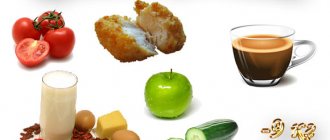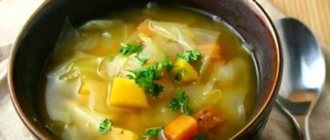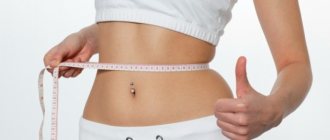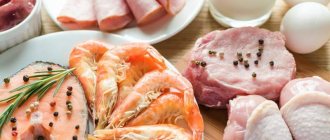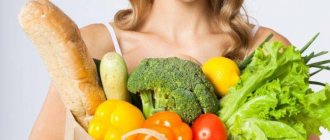- Mechanism of action
- Contraindications
- Recommendations
- Review of the best
- Sample menu
- Recipes
This dietary nutrition program is one of the most ancient.
As has been the custom since ancient times, on certain days associated with the year-round cycle of Orthodox holidays, Christians consciously refuse products of animal origin and lead a modest, reclusive lifestyle. The result is strengthening not only the spirit, but also health. The absence of fat in the diet leads to slimness. This is precisely what the lean diet for weight loss adopted, which borrowed only the principles of proper nutrition from religion.
General rules
Fasting involves cleansing the soul and body.
Because Christians' observance of fasts is more than food rules. Most days of the year are fast days. This is a period of abstinence and testing for believers when temptations and temptations of various kinds arise. Today we will talk about fasting for lay people who do not adhere to strict instructions for believers. Some are going to fast for the first time, so a complete abstinence from food and fasting are not provided for them, but only a reasonable limitation of it.
Compliance with even long fasts (there are four of them), if they are not initially contraindicated for health reasons, cannot harm a person, which is why nutritionists speak positively about fasting. Vegetarian nutrition is not permanent in Orthodoxy - only temporary and intermittent. Outside of fasting days, it is not forbidden to eat eggs, dairy and other products of animal origin; it is obligatory to eat fish, which, along with vegetable oils, according to the instructions of the Church, is considered fast food. Fish has 5 times less connective tissue, so it cooks quickly and is easier to digest in the digestive tract, and its protein is better absorbed.
Fish oils are very useful; they have biological value because they contain polyunsaturated fatty acids (PUFAs), which are important in the dietary prevention of many diseases. Horse mackerel, herring, mackerel, sardine, capelin, notothenia, tuna, salmon, and fish liver are rich in PUFAs.
Temporary deviations from a balanced diet are physiological and necessary to maintain the activity of organs and systems that ensure the absorption of food. According to research by the US National Academy of Nutrition, the system of alternating consumption of meat and vegetarian foods is rational, since the digestive and immune systems receive training and comprehensive health improvement.
A fasting diet excludes meat and animal fats, milk and eggs, confectionery products containing them, sweets, and baked goods. Orthodox cuisine for several weeks includes only plant foods: all vegetables and fruits, soy, buckwheat, rice, legumes, chickpeas, mung bean, mushrooms, peas, seitan, quinoa.
Avoiding food of animal origin is beneficial for the body. Switching to plant foods helps normalize metabolism, reduce cholesterol , restore intestinal microflora and its evacuation function. During the elimination of fatty heavy foods, the body rebuilds its metabolism and during fasting, many manage to normalize their weight.
At the same time, the body is cleansed and gets rid of toxins , cholesterol and lipids, metabolic products, since plant foods are a source of fiber, which acts as a sorbent. Following this diet improves gallbladder function and intestinal motor function - constipation , if such a problem existed.
The Orthodox nutrition system is hypoallergenic. This was noted when observing patients suffering from bronchial asthma , who experienced a decrease in the number of attacks during fasting.
A proper diet during fasting should be varied, then a deficiency of vitamins and minerals will not arise. The most important problem is the lack of protein in the diet, which needs to be replenished by daily consumption of legumes (lentils, peas, soybeans, beans), as well as mushrooms and cereals.
Vegetarian dishes are often prepared from soy, which is superior in protein content to meat and therefore takes first place in this regard. The necessary vitamin B12 is found in sprouted wheat, greens, fish, caviar and seafood (they are allowed during all fasts, but on certain days).
Fish is an almost complete replacement for meat, as it contains enough protein, calcium and vitamins, but contains less iron. Fish must be chosen and cooked correctly. You should give up expensive varieties of fish and prefer low-fat ones: pollock, cod, blue whiting, haddock, hake. It can be boiled or stewed without adding oil, sauces, or various dressings. The diet can be supplemented with seafood: squid, shrimp, mussels and seaweed.
Iron, although in small quantities, is found in vegetables, fruits and cereals: beans, peas, green onions, green vegetables, radishes, beets, tomatoes, watercress, spinach, parsley, pumpkin, millet, buckwheat, pearl barley, barley, oatmeal, brown rice, apples, cherries, pears, persimmons, pomegranates, black currants, figs, nuts, plums, strawberries, raspberries.
The diet of a fasting person should include nuts, sunflower and pumpkin seeds, a variety of vegetable oils (olive, sesame, flaxseed, cedar, pumpkin), which cover the body's need for fats. Soybean oil, obtained from natural soybeans, is a source of vitamins, lecithin .
Nuts contain 15% protein, but fully provide essential amino acids. They are quite nutritious and satiate for a long time, but due to their high fat content they may be poorly tolerated by people with pancreatic enzymatic insufficiency.
The strictest fast and the longest one is Lent . Its duration is 40 days, and with Holy Week - 48 days. It will be difficult for an unprepared person to withstand strict restrictions. The Orthodox prescription recommends going without food for the first two and last days, and then alternating days of dry eating without vegetable oil and days with cooked food without oil.
During the days of Lent, the use of vegetable oil is allowed only on weekends along with boiled food, and fish - twice during the entire period ( Palm Sunday and the Annunciation ); on Lazarus Saturday you can eat fish caviar.
If you decide to strictly adhere to Lent, you can study the Orthodox nutrition calendar, which details the foods and methods of preparing them for 40 days. If we consider it by day, then on Mondays, Wednesdays and Fridays dry food is provided (brown bread, raw fruits and vegetables, compotes, water). On Thursdays and Tuesdays, hot cooked food without vegetable oil (porridge, soups, stewed vegetables, legumes) is allowed. On Sundays and Saturdays - boiled food in vegetable oil.
Having chosen such a diet, try to chew raw food well - this will facilitate its further digestion and relieve discomfort in the stomach and intestines.
There is a nutrition calendar for every day according to a relaxed menu, which is more suitable for the laity. It excludes raw food and all days there is cooked food (soups, cereals, stewed and boiled vegetables), which on certain days is prepared with or without butter.
If a person lives a full church life and often receives communion and performs established fasts, then there is no need to impose additional fasts on him before confession and subsequent communion. There is no such requirement in the canons; they only talk about fasting on Wednesdays and Fridays. However, according to Russian custom, there is a tradition of fasting for three days before Communion , especially when it occurs very rarely (one to four times a year).
Those who receive communion less than twice a month or do not fast on Wednesday and Friday are recommended to fast for three days before receiving communion. This means eating animal foods, eating lean foods in moderation (only to fill you up), and not drinking alcohol. Those who resort to Communion every Sunday can only fast on Wednesday and Friday, and not eat meat dishes on Saturday. 12 hours before communion, do not eat or drink anything. Before confession without communion (it does not have to follow after it), you don’t have to fast. You can confess at any time when there is a need to confess sins and repent.
Nowadays, fasting is often considered as a fasting diet or a method of losing weight. You need to know that fasting is not always effective in terms of weight loss. Often, many people, refusing food of animal origin, experience hunger. To overcome it, the consumption of carbohydrates is increased: bread with vegetable oil, lean pastries, pasta, bread with honey or jam as dessert, fruit, sweet tea.
Their excessive use and excess in the diet can cause metabolic disorders and lead to weight gain by the end of the fast. How to combine healthy fasting and weight loss?
A fasting diet for weight loss should limit cereals (porridge is allowed once a day and in the first half of the day), as well as nuts (no more than 10 pieces per day), since they are quite high in calories and are not suitable for those who are trying to lose weight. The basis of the diet should be vegetables, mushrooms, legumes, fruits, seaweed and low-calorie soy products (tofu, soy milk and soy yogurt). Protein products of plant origin must be present in the diet, since fasting lasts 48 days. Legumes and soy products should be included daily.
After the post
Whatever nutrition option you choose, after fasting you need to observe moderation in food in order to gradually bring the body back to its usual diet. During this time, the body has become unaccustomed to digesting and assimilating meat foods and has rebuilt the functioning of the gastrointestinal tract.
First, egg whites are introduced into the diet - they are considered the easiest to digest. Then - dairy proteins, chicken and lean pork. Difficult-to-digest proteins of lamb, beef and goose meat are introduced last (a week after Easter ). It is best to cook from lean, boiled meat, eat boiled fish and continue to use vegetable oil and stewed vegetables.
Meals should be fractional; large amounts of food should not be abused. If a person has strictly observed fasting, one should limit alcoholic beverages and give up fatty and smoked foods. This is precisely the main mistake of people who believe that they have endured fasting with dignity and that on Easter day they can treat themselves to previously forbidden food. This leads to exacerbation of diseases of the gastrointestinal tract, primarily pancreatitis .
Recommendations
Experts have proven that a lean diet has a positive effect on the health of the human body. Restriction in food and its selective consumption help reduce the risk of developing atherosclerosis, cardiovascular diseases and liver pathologies.
Dietary nutrition will gradually help rid the body of harmful substances, toxins and waste. And the result on the scale inspires even more.
When following a diet, it is important to adhere to the following rules:
- It is not recommended to follow a lean diet more than once every three months;
- Every day you need to adhere to 5-6 meals a day;
- Food portions should be small;
- You can't overeat;
- You will have to give up snacking between main meals. If you are completely unbearable, you are allowed to eat a few nuts or dried fruits;
- Complete refusal of sweets, baked goods, alcohol;
- You can eat three tablespoons of honey per day;
- Light physical activity is allowed in the form of walking, morning exercises;
- If you need to lose more than ten kilograms, the duration of the diet can be more than two weeks;
- It is important to maintain a drinking regime. A large intake of fluid helps to quickly remove toxins from the body. You are allowed to drink clean water, green tea, and freshly squeezed juices.
- Dishes must be steamed or stewed;
- It is imperative to maintain a sleep schedule. You need to sleep at least eight hours a day.
Following these simple recommendations will help you lose excess weight, albeit for a short time.
Authorized Products
The fasting diet for each day includes:
- Fresh and stewed vegetables, salads, vinaigrette. Cutlets made from carrots, cabbage, potatoes or mushrooms. In winter, frozen vegetables are used.
- Boiled legumes, soups with legumes, bean and pea pates.
- Soy products: milk, mayonnaise, cottage cheese.
- Vegetarian soups with vegetables, dumplings, mushrooms and cereals.
- Dumplings with potatoes, mushrooms or cabbage.
- Mushrooms, stewed or baked.
- Any cereals and pasta. Porridges are boiled in water, and vegetable oil is added to the finished ones.
- Various fruits and dried fruits.
- Pickles and pickles.
- Jams and jams.
- Whole grain bread, rye, bran bread. Pancakes, pita bread, pies, cooked with water and without eggs.
- Vegetable and fruit juices, infusions of herbs and fruits, compotes, mineral water, green tea with lemon, cranberry and other fruit drinks.
- Various types of nuts and seeds.
- Vegetable oil for adding to dishes (on certain days).
- Boiled or stewed fish of low-fat varieties (on certain days).
Table of permitted products
| Proteins, g | Fats, g | Carbohydrates, g | Calories, kcal | |
Vegetables and greens | ||||
| greenery | 2,6 | 0,4 | 5,2 | 36 |
| eggplant | 1,2 | 0,1 | 4,5 | 24 |
| beans | 6,0 | 0,1 | 8,5 | 57 |
| zucchini | 0,6 | 0,3 | 4,6 | 24 |
| cabbage | 1,8 | 0,1 | 4,7 | 27 |
| broccoli | 3,0 | 0,4 | 5,2 | 28 |
| boiled cauliflower | 1,8 | 0,3 | 4,0 | 29 |
| bulb onions | 1,4 | 0,0 | 10,4 | 41 |
| carrot | 1,3 | 0,1 | 6,9 | 32 |
| cucumbers | 0,8 | 0,1 | 2,8 | 15 |
| salad pepper | 1,3 | 0,0 | 5,3 | 27 |
| radish | 1,2 | 0,1 | 3,4 | 19 |
| white radish | 1,4 | 0,0 | 4,1 | 21 |
| red radish | 1,2 | 0,1 | 3,4 | 20 |
| black radish | 1,9 | 0,2 | 6,7 | 35 |
| salad | 1,2 | 0,3 | 1,3 | 12 |
| beet | 1,5 | 0,1 | 8,8 | 40 |
| celery | 0,9 | 0,1 | 2,1 | 12 |
| soybeans | 34,9 | 17,3 | 17,3 | 381 |
| asparagus | 1,9 | 0,1 | 3,1 | 20 |
| tomatoes | 0,6 | 0,2 | 4,2 | 20 |
| pumpkin | 1,3 | 0,3 | 7,7 | 28 |
| beans | 7,8 | 0,5 | 21,5 | 123 |
| garlic | 6,5 | 0,5 | 29,9 | 143 |
| lentils | 24,0 | 1,5 | 42,7 | 284 |
| spinach | 2,9 | 0,3 | 2,0 | 22 |
| sorrel | 1,5 | 0,3 | 2,9 | 19 |
Fruits | ||||
| avocado | 2,0 | 20,0 | 7,4 | 208 |
| oranges | 0,9 | 0,2 | 8,1 | 36 |
| bananas | 1,5 | 0,2 | 21,8 | 95 |
| pomegranate | 0,9 | 0,0 | 13,9 | 52 |
| grapefruit | 0,7 | 0,2 | 6,5 | 29 |
| pears | 0,4 | 0,3 | 10,9 | 42 |
| kiwi | 1,0 | 0,6 | 10,3 | 48 |
| lemons | 0,9 | 0,1 | 3,0 | 16 |
| tangerines | 0,8 | 0,2 | 7,5 | 33 |
| nectarine | 0,9 | 0,2 | 11,8 | 48 |
| peaches | 0,9 | 0,1 | 11,3 | 46 |
| apples | 0,4 | 0,4 | 9,8 | 47 |
Berries | ||||
| grape | 0,6 | 0,2 | 16,8 | 65 |
| gooseberry | 0,7 | 0,2 | 12,0 | 43 |
| Red currants | 0,6 | 0,2 | 7,7 | 43 |
| black currant | 1,0 | 0,4 | 7,3 | 44 |
Mushrooms | ||||
| mushrooms | 3,5 | 2,0 | 2,5 | 30 |
| frozen assorted mushrooms | 2,2 | 0,8 | 0,7 | 20 |
| fresh champignons | 4,3 | 1,0 | 1,0 | 27 |
| fresh milk mushrooms | 1,8 | 0,5 | 0,8 | 16 |
| fresh chanterelles | 1,6 | 1,1 | 2,2 | 20 |
| fresh oyster mushrooms | 2,5 | 0,5 | 6,2 | 34 |
| fresh boletus | 2,4 | 0,7 | 1,7 | 9 |
| fresh honey mushrooms | 2,2 | 1,2 | 2,8 | 17 |
| fresh saffron milk caps | 1,9 | 0,8 | 2,7 | 17 |
Nuts and dried fruits | ||||
| nuts | 15,0 | 40,0 | 20,0 | 500 |
| dried fruits | 2,3 | 0,6 | 68,2 | 286 |
| raisin | 2,9 | 0,6 | 66,0 | 264 |
| cashew | 25,7 | 54,1 | 13,2 | 643 |
| sesame | 19,4 | 48,7 | 12,2 | 565 |
Cereals and porridges | ||||
| buckwheat (kernel) | 12,6 | 3,3 | 62,1 | 313 |
| oat groats | 12,3 | 6,1 | 59,5 | 342 |
| corn grits | 8,3 | 1,2 | 75,0 | 337 |
| pearl barley | 9,3 | 1,1 | 73,7 | 320 |
| millet cereal | 11,5 | 3,3 | 69,3 | 348 |
| rice | 6,7 | 0,7 | 78,9 | 344 |
Flour and pasta | ||||
| pasta | 10,4 | 1,1 | 69,7 | 337 |
Confectionery | ||||
| jam | 0,3 | 0,2 | 63,0 | 263 |
| jam | 0,3 | 0,1 | 56,0 | 238 |
Raw materials and seasonings | ||||
| honey | 0,8 | 0,0 | 81,5 | 329 |
Cheeses and cottage cheese | ||||
| curd tofu | 8,1 | 4,2 | 0,6 | 73 |
Fish and seafood | ||||
| seaweed | 0,8 | 5,1 | 0,0 | 49 |
Oils and fats | ||||
| linseed oil | 0,0 | 99,8 | 0,0 | 898 |
| olive oil | 0,0 | 99,8 | 0,0 | 898 |
| sunflower oil | 0,0 | 99,9 | 0,0 | 899 |
Non-alcoholic drinks | ||||
| mineral water | 0,0 | 0,0 | 0,0 | — |
| green tea | 0,0 | 0,0 | 0,0 | — |
| black tea | 20,0 | 5,1 | 6,9 | 152 |
| * data is per 100 g of product | ||||
How to prepare dishes?
All dishes intended for a lean diet should be cooked exclusively by steaming or in the oven. Frying dishes is strictly prohibited, because this process is carried out with the addition of oil of animal origin, which in this case is strictly prohibited. All porridges are prepared only with water; dairy products are strictly prohibited.
There are standard recipes for a lean diet that can be prepared in a matter of minutes. The process uses only natural products and no food additives. Consider a list of recipes that are worth paying attention to.
Ratatouille
For cooking, the most delicious and healthy vegetables are used, which can saturate the body with the necessary components, accelerating metabolic processes.
Have to take:
- Greenery.
- Garlic.
- Onion.
- Bell pepper.
- Tomato juice.
- Zucchini.
- Eggplant.
- Salt.
Preparation:
- Peel the eggplants and zucchini, cut into rings 1 cm wide;
- Tomatoes should be poured with boiling water to make it easier to peel them;
- Chop the sweet pepper, onion and garlic, simmer with the addition of tomato sauce;
- Place parchment paper in a baking dish and pour the prepared sauce with vegetables on top;
- Next, you need to place all the cooked and chopped vegetables on food parchment, alternating them with each other;
- At the end, the dressing is prepared. It consists of chopped herbs, salt and garlic. Vegetables are lubricated with it on top;
- The mold is placed in the oven for 90 minutes at 180 degrees.
Avocado vegetable salad
To prepare you will need:
- 2 cucumbers.
- 2 tomatoes.
- Radish.
- Avocado.
- Lemon juice.
- Onion.
- Salt.
The preparation is very simple:
- All vegetables are chopped into cubes, including avocados;
- The onion should be marinated in lemon juice for up to 10 minutes;
- All ingredients are mixed, salt is added;
- Top the salad with lemon juice.
These simple recipes for preparing vegetables will help you observe fasting days correctly, without harm to your health. It is enough to cook various porridges in water in combination with such salads and the body will be fully saturated with the components it needs.
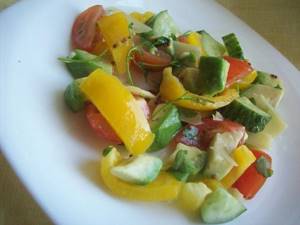
Fully or partially limited products
- All types of meat.
- Poultry meat.
- Smoked meats, sausages, canned food.
- Dairy products, including butter.
- Eggs.
- Animal fats.
- Fried foods.
- Baked goods containing eggs and dairy products, sweets, dough products, chocolate, ice cream, cakes.
- Alcoholic drinks.
Table of prohibited products
| Proteins, g | Fats, g | Carbohydrates, g | Calories, kcal | |
Confectionery | ||||
| candies | 4,3 | 19,8 | 67,5 | 453 |
| pastry cream | 0,2 | 26,0 | 16,5 | 300 |
| cookie | 7,5 | 11,8 | 74,9 | 417 |
Ice cream | ||||
| ice cream | 3,7 | 6,9 | 22,1 | 189 |
Cakes | ||||
| cake | 4,4 | 23,4 | 45,2 | 407 |
Chocolate | ||||
| chocolate | 5,4 | 35,3 | 56,5 | 544 |
Raw materials and seasonings | ||||
| mayonnaise | 2,4 | 67,0 | 3,9 | 627 |
Dairy | ||||
| milk 3.6% | 2,8 | 3,6 | 4,7 | 62 |
| milk 4.5% | 3,1 | 4,5 | 4,7 | 72 |
| cream | 2,8 | 20,0 | 3,7 | 205 |
| sour cream 25% (classic) | 2,6 | 25,0 | 2,5 | 248 |
| natural yogurt 2% | 4,3 | 2,0 | 6,2 | 60 |
Cheeses and cottage cheese | ||||
| cheese | 24,1 | 29,5 | 0,3 | 363 |
| cottage cheese 11% | 16,0 | 11,0 | 1,0 | 170 |
| cottage cheese 18% (fat) | 14,0 | 18,0 | 2,8 | 232 |
Meat products | ||||
| pork | 16,0 | 21,6 | 0,0 | 259 |
| pork liver | 18,8 | 3,6 | 0,0 | 108 |
| pork kidneys | 13,0 | 3,1 | 0,0 | 80 |
| pork fat | 1,4 | 92,8 | 0,0 | 841 |
| salo | 2,4 | 89,0 | 0,0 | 797 |
| beef | 18,9 | 19,4 | 0,0 | 187 |
| beef liver | 17,4 | 3,1 | 0,0 | 98 |
| beef kidneys | 12,5 | 1,8 | 0,0 | 66 |
| beef brains | 9,5 | 9,5 | 0,0 | 124 |
| mutton | 15,6 | 16,3 | 0,0 | 209 |
| meat pate | 16,4 | 23,3 | 0,4 | 277 |
Sausages | ||||
| smoked sausage | 16,2 | 44,6 | 0,0 | 466 |
| smoked sausage | 9,9 | 63,2 | 0,3 | 608 |
| sausages | 10,1 | 31,6 | 1,9 | 332 |
| sausages | 12,3 | 25,3 | 0,0 | 277 |
Bird | ||||
| smoked chicken | 27,5 | 8,2 | 0,0 | 184 |
| chicken fillet | 23,1 | 1,2 | 0,0 | 110 |
| duck | 16,5 | 61,2 | 0,0 | 346 |
| smoked duck | 19,0 | 28,4 | 0,0 | 337 |
| goose | 16,1 | 33,3 | 0,0 | 364 |
Eggs | ||||
| eggs | 12,7 | 10,9 | 0,7 | 157 |
Fish and seafood | ||||
| fish | 18,5 | 4,9 | 0,0 | 136 |
| smoked fish | 26,8 | 9,9 | 0,0 | 196 |
| salted fish | 19,2 | 2,0 | 0,0 | 190 |
| canned fish | 17,5 | 2,0 | 0,0 | 88 |
| cod (liver in oil) | 4,2 | 65,7 | 1,2 | 613 |
Oils and fats | ||||
| animal fat | 0,0 | 99,7 | 0,0 | 897 |
| cooking fat | 0,0 | 99,7 | 0,0 | 897 |
| * data is per 100 g of product | ||||
Diet menu at the post (Meal mode)
According to church nutrition rules, food should be taken twice a day, but this regime is unlikely to be suitable for working people leading an active lifestyle. Moreover, it is not suitable for weight loss. A long break from eating less nutritious food will cause increased appetite and larger portions at dinner. In addition, at breakfast you will also try to eat more so that you “have enough” until the evening.
From a nutritional point of view, it is optimal to eat 3-4 times, but in small portions. A variety of lean foods helps create a varied menu. The diet for Lent should include as many vegetable dishes as possible, dishes made from legumes, mushrooms, soy products, cereals, muesli, unsweetened corn flakes and juices, which can serve as a main dish and as a snack.
It is difficult for a modern person to do without spices, so they can be added to vegetable dishes and soups, but in moderation. Below is an approximate diet for a week. If it is strictly observed, on Monday, Wednesday and Friday, dishes are prepared without vegetable oil, the remaining four days of the week - with oil.
Menu meals during fasting, starting from the second week:
Monday
| Breakfast |
|
| Dinner |
|
| Afternoon snack |
|
| Dinner |
|
Tuesday
| Breakfast |
|
| Dinner |
|
| Afternoon snack |
|
| Dinner |
|
Wednesday
| Breakfast |
|
| Dinner |
|
| Afternoon snack |
|
| Dinner |
|
Thursday
| Breakfast |
|
| Dinner |
|
| Afternoon snack |
|
| Dinner |
|
Friday
| Breakfast |
|
| Dinner |
|
| Afternoon snack |
|
| Dinner |
|
Saturday
| Breakfast |
|
| Dinner |
|
| Afternoon snack |
|
| Dinner |
|
Sunday
| Breakfast |
|
| Dinner |
|
| Afternoon snack |
|
| Dinner |
|
This diet pattern can be repeated until the end of the fast. The exception is the last week, when abstinence from food is recommended on the Friday before Easter.
Contraindications
The Lenten diet is prohibited for use by people with the following diseases:
- Anemia;
- Anorexia;
- Intestinal tract disorders;
- Infections;
- Oncological diseases
The diet is also not recommended during the following periods:
- Pregnancy period;
- Breast-feeding;
- Childhood;
- Elderly age;
- Rehabilitation period;
Before starting a diet, it is best to visit a doctor to receive detailed and individual recommendations and advice.
Lent food recipes
Dietary meals should be varied so that long-term fasting is easily tolerated and enjoyable. The industry also helps with this, providing marshmallows, lean cheeses, crackers from sprouted wheat, robi (vegetarian meat from a mixture of vegetable proteins, red beets and wheat sprouts), tofu, soy mayonnaise and other soy products for fasting. It’s not a problem to find recipes for lean dietary dishes and prepare healthy and tasty food yourself.
Lenten soups
Lentil soup
Ingredients: 100-150 g lentils, 2-3 potatoes, carrots, onions, celery stalk, 1-2 tbsp. tomato paste, garlic, salt and pepper to taste, 3 tbsp. vegetable oil, lemon juice, dill or parsley.
Lenten Lentil Soup
Pour 2-2.5 liters of water over the lentils and cook for 20-30 minutes after boiling. Cut the potatoes into large cubes and place them in the pan. Grate the carrots, finely chop the onion and celery. Fry onions, carrots, tomato paste and celery in vegetable oil. Add all vegetables to lentils and potatoes. Season with salt, garlic, pepper. Cook for 15 minutes until the potatoes are ready, at the end you can add lemon juice and chopped herbs if desired.
Shchi with sauerkraut and mushrooms
Ingredients: 100 g mushrooms (preferably dried white ones), 200 g sauerkraut, carrots, onions, tomato or tomato paste, salt, garlic, 3 tbsp. vegetable oil.
Lenten cabbage soup with mushrooms
Soak dried mushrooms in advance and then cook. If you use fresh ones, cut them and simmer in vegetable oil along with onions, carrots and a small amount of tomato paste or peeled chopped tomatoes. Squeeze the cabbage and, if desired, cut it into smaller pieces and simmer in a separate frying pan until soft. Place stewed cabbage, mushrooms, onions and carrots in a saucepan, let it boil and cook for half an hour. In the case of dry mushrooms, they are poured along with the broth into a common pan with vegetables. Ready cabbage soup is seasoned with salt, garlic and pepper.
Lenten baking
Pies with mushrooms and potatoes
Ingredients for the dough: a glass of water, 1-2 tsp. dry yeast, 3 cups flour (or less), 3/4 cup vegetable oil, 1 tbsp. l. sugar, 0.5 tsp. salt. For filling: 4-5 pcs. potatoes, 300 g mushrooms, salt, black pepper, vegetable oil for frying, onions, 2 cloves of garlic.
Pies with mushrooms and potatoes
Mix yeast with warm water, sugar and add 2 tbsp. l. flour. Leave the dough for a while. Then add salt, vegetable oil and gradually add sifted flour. Mix well with a spoon, and then knead with your hands, adding the remaining flour. You should get a soft dough, which is left for an hour in a warm place. The risen dough is kneaded and left again for a while.
Boil potatoes in salted water and mash. Fry the chopped onions and mushrooms until the onions are browned. Mix potatoes with fried mushrooms, salt, add garlic squeezed through a press and pepper. Divide the dough into small balls, from which you make pies with filling. The finished pies should be left on a baking sheet for 20-25 minutes, covered with a towel. Preheat the oven to 1800. Grease the pies with vegetable oil (you can use a strong infusion of tea). Bake for 20 minutes. until browned.
Who should not fast
Doctors warn that not everyone can fast and follow a strict eating regimen. Contraindications for fasting should be taken into account if you fall into the following categories:
- with chronic diseases;
- when doing hard work;
- pregnant, nursing mothers;
- children under 14 years of age;
- people who have recently suffered mental or emotional trauma or serious illness;
- rehabilitation process;
- ulcer, pancreatitis, gastritis;
- diabetes;
- renal failure.
Advantages and disadvantages
| pros | Minuses |
|
|
Nutritionist opinion
Most experts agree that with the correct preparation of the diet, the method has no contraindications and is suitable for absolutely everyone.
But they warn against inadequate intake of microelements and vitamins into the body.

People in physical professions should pay special attention to calorie content.
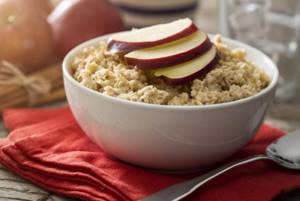
After all, if you are not an athlete in the pre-competition period, the meager energy value will lead to the opposite of the desired results, and can contribute to the development of a number of pathologies.

Therefore, do not be lazy to count calories, and monitor the condition of your body. At the slightest symptoms of excessive fatigue or nervous exhaustion, you should stop the diet.
Reviews and results
Fasting is not a method of losing weight, but a spiritual cleansing first and foremost. Gluttony is a sin, and fasting helps to get rid of it. A believer easily endures dietary restrictions and perceives it differently. It's all about faith.
Many people use fasting for the purpose of losing weight. Do not confuse fasting, which includes much more than just food restrictions, and diet during fasting. The results are different for everyone: on average, weight loss is 3-5 kg. Most complain of weight gain due to increased appetite and consumption of mainly carbohydrate foods (potatoes, pasta, bread, cereals), which muffled the feeling of hunger.
- “... I studied all the rules of nutrition during fasting, but did not decide on strict restrictions with hunger and a raw food diet. I just cooked hot food all day, but added oil every other day. Of course, compared to what I ate before, this was a significant restriction. All day I ate various cereals, stewed vegetables or salads, to which I added butter and nuts. I cooked soups in water, but fried them, as they are tasteless without frying in vegetable oil. I liked the stewed vegetables with mushrooms. It turned out that fasting can be easily postponed if you think about all the dishes in advance and are not lazy about cooking. Since I did not pursue the goal of losing weight, I prepared dumplings with potatoes and mushrooms, pancakes with vegetables and mushrooms and other flour dishes. However, I managed to reduce my weight by 3 kg.”
- “... I decided to fast for health reasons. Constipation, bloating and discomfort in the intestines began to bother me. A table of meals helped me with nutrition, which describes everything by day. By the way, it includes not only Lent, but also Assumption, Petrov and Rozhdestven. I took this into account and will fast 4 times a year (the other three are not so strict). I cooked everything boiled, since I couldn’t eat raw vegetables due to pain and bloating in the intestines. Indeed, such restrictions helped me - after a week the stool returned to normal.”
- “... I started fasting, hoping to lose weight. Of course, if you constantly eat potatoes and bread, you will gain weight. I decided that buckwheat, vegetables, mushrooms, fruits, nuts (only a little), soy meat would become my main products. For breakfast I eat porridge with vegetables, but in moderation. For lunch - vegetable soup or stewed vegetables with soy meat or beans (lentils). In the evening, only vegetable salad with tofu cheese and nuts. Bread was sharply limited and no sweets. I eat a lot of fruit and drink juice. Sometimes I allowed myself dark chocolate (it’s without milk), because sometimes I felt dizzy. I ate soy mayonnaise, it is low in calories and I used it in salads, sometimes spread it on bread when I was really hungry. She led a normal lifestyle - work and light exercise in the gym. I can't say that everything was smooth. There were days when the feeling of hunger did not give rest, then I ate bread or Lenten pastries. I can boast that in 48 days I lost 10 kg. I agree that not everyone is like this, maybe I have such a metabolism.”
Experts' opinion
Most doctors, nutritionists, and psychologists consider fasting to be beneficial for humans. Even those who do not believe in God leave reviews about the effectiveness of fasting in healing the body.
The opinion of experts is clear: you can lose weight during fasting, but at the end of fasting you should adhere to a balanced diet. A person should eat according to the rule “get up from the table with a slight feeling of hunger.”
The clergy also believe that it is possible to lose weight during fasting, but this should not be made a goal. Trying to get rid of the sin of gluttony, you can easily fall into the sin of narcissism (pride).
There are many ordinary people who fast. Everyone does this to the best of their strength and health. And to each is given according to his faith.
